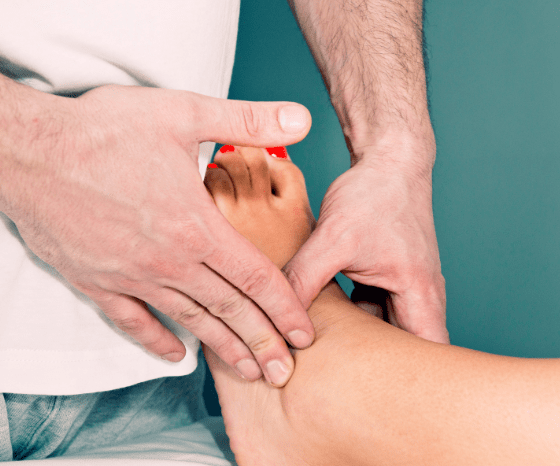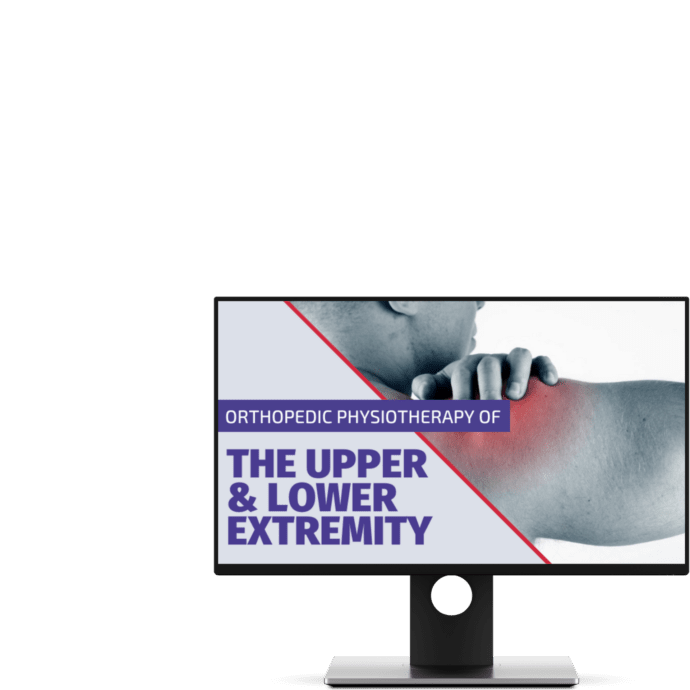Lateral Ankle Sprain | Diagnosis & Treatment

Syndesmotic Injuries | Diagnosis & Treatment
As physiotherapists, it is important to be aware of acute syndesmotic injuries as a differential diagnosis in patients presenting with lateral ankle sprains. It requires longer recovery times and more treatments compared with lateral ankle sprains (Gerber et al., 1998). Delayed diagnosis may result in impingement of scar tissue, chronic ankle instability, heterotopic ossification, or osteoarthritis further down the line (Nussbaum et al., 2001, Ogilvie-Harris et al., 1994). You are here to learn how to recognize these early on and provide appropriate treatment.
Syndesmotic injuries refer to trauma-related injuries to the complex of ligaments that connect the tibia and fibula bones of the leg, including the anterior inferior tibiofibular ligament, the interosseous ligament, and the posterior inferior tibiofibular ligament. These injuries are a common differential diagnosis in patients presenting with lateral ankle sprains and can have a significant impact on the healing process and long-term outcome.
Early Recognition
Early recognition of syndesmotic injuries is crucial for physiotherapists, as these injuries often require different treatment approaches than a typical ankle sprain. Delayed recognition and treatment can result in inappropriate or inadequate management, leading to persistent symptoms and potential long-term complications (Nussbaum et al., 2001, Ogilvie-Harris et al., 1994).
Weary of a syndesmotic injury? Watch this video to see if it matches the signs and symptoms.
Mechanism of Injury
Syndesmotic injuries are commonly caused by high-impact trauma, such as falls from a height or motor vehicle accidents, or by excessive external rotation with hyper-dorsiflexion of the ankle joint. These mechanisms can result in sprains or even ruptures of the ligaments in the syndesmotic complex. Isolated syndesmotic injuries are relatively uncommon so be aware of potential fractures, associated ligament ruptures, bone bruises, osteochondral lesions, or other soft tissue injuries (van Dijk et al., 2016).
Follow a course
- Learn from wherever, whenever, and at your own pace
- Interactive online courses from an award-winning team
- CEU/CPD accreditation in the Netherlands, Belgium, US & UK
Clinical Presentation & Examination
Diagnosis
Risk Factors
Sports with high-speed collisions, artificial surfaces, unlevel ground, and high-torque cutting and jumping forces, which can cause dorsiflexion and external rotation of the foot in relation to the ankle and tibia, are more likely to cause syndesmotic injuries (eg, football, soccer, basketball, rugby, skiing, hockey) (Hunt et al., 2013).
Clinical Evaluation
The diagnosis of syndesmotic injuries includes a thorough history and physical examination, as well as imaging tests such as X-rays, CT scans, MRI scans, or ultrasound to confirm the presence of a syndesmotic injury and to rule out other potential causes of pain and instability in the ankle joint.
Physical Examination
During the physical examination, the physiotherapist will assess the patient’s range of motion, stability, and pain in the affected joint. Special tests, such as the squeeze test or the external rotation stress test, may be performed to further evaluate the integrity of the syndesmotic complex. When a syndesmotic injury is suspected, imaging is recommended (van Dijk et al., 2015).
Tenderness on palpation of the syndesmosis ligaments is the most sensitive test while the squeeze test is the most specific (Sman et al., 2015). Both being positive results in a high probability of injury to the syndesmosis ligaments.
In terms of classification, many models have been proposed. Currently, there is no consensus on what classification to use. As a broad guide, you can divide them into stable and unstable joints, and isolated and non-isolated injuries.
Palpation syndesmosis ligaments:
Squeeze test:
Other tests you might consider are:
The Cotton test:
The fibular translation test:
Heel thump test:
Imaging Tests
In terms of imaging, X-rays can provide information about the position and alignment of the ankle joint, while CT scans and MRI scans can provide more detailed information about the ligaments and surrounding soft tissues. Magnetic resonance imaging has excellent sensitivity and specificity for visualizing syndesmotic injuries, although an arthroscopy remains the gold standard. Diastasis can be present, resulting in an unstable joint (van Dijk et al., 2015). To assess this appropriately, a unilateral weight-bearing film is preferred. However, patients may not tolerate this in the early phase (Lin et al., 2006).
Be aware of a potential Maisonneuve fracture. This is a commonly missed fracture of the proximal fibula that might occur during ankle trauma (Taweel et al. 2013)
LEVEL UP YOUR ROTATOR CUFF DISORDER KNOWLEDGE – FOR FREE!

Follow a course
- Learn from wherever, whenever, and at your own pace
- Interactive online courses from an award-winning team
- CEU/CPD accreditation in the Netherlands, Belgium, US & UK
Treatment
Conservative Management
If there is no evidence of fractures, instability, or diastasis, and the deltoid ligaments remain intact, conservative management is often the first line of treatment. This may include a short cast or brace (van Dijk et al., 2015), activity modification, possibly ice, compression, and elevation of the affected joint. Pain management strategies, such as over-the-counter pain medication or prescription pain medication, may also be used to alleviate pain and swelling. In contrast to lateral ankle sprains, a period of immobilization may be recommended to avoid excessive stress on the distal tibiofibular joint in the acute phase. The duration ranges from a few days to weeks and can be done with a cast or brace.
Physical therapy, including exercises to restore range of motion, strength, and stability, is an important part of the rehabilitation process for patients with syndesmotic injuries (Chen et al., 2019). We make use of the lateral ankle sprain guidelines for conservative rehab since no guidelines exist around syndesmotic sprains.
Surgery
In some cases, surgery may be required to correct a syndesmotic injury and restore stability to the affected joint. This may include procedures such as syndesmotic screw fixation, suture anchors, or syndesmotic reduction and fixation. The decision to proceed with surgery will be based on the severity of the injury and the patient’s overall health and rehabilitation goals (Hunt et al., 2015).
After the surgery, a period of non-weight bearing or forms of immobilization may be used, at the discretion of the surgeon.
Rehabilitation
Rehabilitation is a crucial component of the management of syndesmotic injuries and is typically started once the patient is pain-free and able to bear weight on the affected joint. Physical therapy, including exercises to restore range of motion, strength, and stability, is an important part of the rehabilitation process for patients with syndesmotic injuries. The rehabilitation process may also include the use of assistive devices, such as crutches or a brace, to aid in the healing process and prevent re-injury (Chen et al., 2019).
There is currently no separate guideline for treating syndesmotic sprains conservatively or rehabbing them after surgery. Therefore, several authors suggest falling back on the lateral ankle sprain rehab guidelines. These are seen below.
Rest, ice, compression, elevation (RICE)
Trials have not provided strong evidence for the use of cold and compression in alleviating injury-related symptoms after acute LAS. Despite the fact that cryotherapy has been studied in 33 randomized controlled studies including a total of 2337 participants, the scant research suggests that it may not be effective in easing acute LAS symptoms. Evidence does not support the efficacy of RICE alone, cryotherapy alone, or compression therapy alone in reducing pain, swelling, or enhancing patient function in acute LAS. Consequently, while treating patients with acute LAS, physiotherapy professionals should carefully assess the use of cryotherapy and take alternate therapeutic options into consideration (Vuurberg et al. 2018).
Medication
NSAIDs may be used by patients with acute LAS to reduce pain and swelling, but they should be used with caution as their use is linked to problems and may prevent or delay the body’s natural healing process (Vuurberg et al. 2018).
Resistance training
It is advised to measure ankle joint strength using handheld dynamometers since people with chronic ankle joint instability have impairments in this area (Delahunt et al. 2019). Targeting the hips may be something to think about since evidence suggests that those with chronic ankle instability have diminished hip strength as well (McCann et al. 2017).
Exercise
It is advised that physical therapists start exercise treatment programs as soon as possible after an acute LAS injury because these programs have been shown to hasten recovery and enhance results while also lowering the risk of repeat injuries and functional ankle instability. A home training regimen may not be as successful for patients with severe ankle sprains as supervised physical treatment, which increases ankle strength and proprioception and enables a quicker return to work and sports. It is crucial to keep in mind that some studies have found the opposite, demonstrating either no benefit from adding supervised exercise therapy to conventional treatment alone or no change in postural balance following exercise therapy. Because of this, exercise treatment programs should be carefully customized based on the needs of patients and the amount of monitoring (Vuurberg et al. 2018).
You might assess swelling with the figure figure-of-eight method to see whether there are any improvements.
Also, determining the person’s level of activity prior to the injury is crucial for the specificity of your workout program.(Delahunt et al. 2019).
Manual therapy
It is ideal to combine manual therapy, such as joint mobilizations, with an exercise regimen. Exercise and mobilizations seem to be preferable to exercise at home alone (Cleland et al. 2013). In the short term, they seem to increase dorsiflexion range of motion and lessen pain (Loudon et al. 2013).
References
Follow a course
- Learn from wherever, whenever, and at your own pace
- Interactive online courses from an award-winning team
- CEU/CPD accreditation in the Netherlands, Belgium, US & UK
ORTHOPEDIC PHYSIOTHERAPY OF THE UPPER AND LOWER EXTREMITIES



